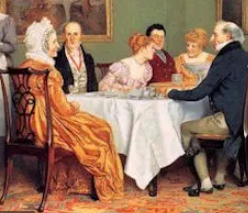
Some historians attibute the invention of the bathing machine to Benjamin Beale, a Quaker and a glove and breeches maker who lived in Margate, a coastal seaside resort in England, during the 18th century. This was not so. Beale’s actual contribution in 1750 was the invention of an awning attached to the rear of the bathing machine. The cloth hood became popularly known as a modesty hood. It could be lowered in front of the machine down to the water and provide a private bathing area for the modest swimmer. There were variations to the hood, such as a canvas awning called a lift, which could be extended over the back of the cart like a tent and completely hide the bather from view. An additional benefit of the hood was that it also protected delicate skin from the sun.
During the 18th and 19th centuries, people did not bathe in the sea for pleasure but for their health. After the publication of the Use of Seawater in the Diseases of the Glands by Dr Richard Russell in 1752, sea bathing became more fashionable.

Ramsgate bathing machines off the High Street
The engraving above is an early version of the of the lower High Street in Margate in Benjamin Beale’s time before the Bathing rooms were constructed. The view from the bay shows how the Bathing Machines were accessed from the lower High Street.

Woman swimming in the sea; the need for privacy in such a situation is acute
It was considered inappropriate for the upper and middle classes to swim in the waves together, thus bathing machines became popular. Modesty and decorum dictated that the opposite sex should bathe in isolation from each other, for nude bathing for both sexes was common until the Victorian age. “It is believed that naked bathing continued until 1862, when a law was passed stating that male and female bathers were to be segregated by not less than 60 feet, and that all owners of bathing machines would provide gowns or dresses to female bathers and drawers or similar to male bathers.” After swimming, bathers would re-enter the bathing machine, dry off, and change back to their street clothing. The bathing machine would be wheeled back to the beach and the bather would emerge fully dressed. “The hiring charge for a bathing machine in 1770 varied from 9d for two or more gentlemen bathing themselves to 1/6d for a gentleman taking a machine with a guide.”*

Bathing machine and attendants
Imagine to yourself a small, snug, wooden chamber, fixed upon a wheel-carriage, having a door at each end, and on each side a little window above, a bench below – The bather, ascending into this apartment by wooden steps, shuts himself in, and begins to undress, while the attendant yokes a horse to the end next the sea, and draws the carriage forwards, til the surface of the water is on a level with the floor of the dressingroom, then he moves and fixes the horse to the other end – The person within being stripped, opens the door to the sea-ward, where he finds the guide ready, and plunges headlong into the water – After having bathed, he re-ascends into the apartment, by the steps which had been shifted for that purpose, and puts on his clothes at his leisure, while the carriage is drawn back again upon the dry land; so that he has nothing further to do, but to open the door, and come down as he went up – Should he be so weak or ill as to require a servant to put off and on his clothes, there is room enough in the apartment for half a dozen people. – The Expedition of Humphrey Clinker, Tobias Smollett, 1771

Beale bathing machine
Beale did not get rich off his invention, and he was reduced to poverty after his machines were destroyed in storms.
“The public are obliged to Benjamin Beale, one of the people called Quakers, for the invention,” writes the author of A Short Description of the Isle of Thanet, published in 1796. But it was the old story; the public became grateful after the inventor had been ruined by his enterprise. His successors had reaped the harvest. Old Benjamin Beale’s widow could remember in her last days the first family that ever resorted to Margate for the purpose of bathing being carried into the sea in a covered cart. In 1803 Beale’s machines were one of the institutions of Margate. It was alarmingly claimed for them that “they may be driven to any depth into the sea by careful guides.” – New York Times, August 11, 1906

The design of the bathing machine changed little in 150 years, and most, except those built for the rich, remained nothing more than damp wooden boxes on wheels. In the 1865 lithograph of the Southsea above, Beale bathing machines can be seen with their awnings fully unfurled to the water.








I enjoyed reading this! I was just looking up Margate beach because I have some old pictures from there. They mentioned the bathing machine and my picture actually show them being hauled into the water.
Psst, Vic, I emailed you my address. Just making sure you get it. :) Thanks!
I did, BB. Sourcebooks has your address. :)
These bathing machines are fascinating, and frightening at the same time,. I love reading stuff like this, thanks so much for sharing!
Thanks, Jean and Sue. I am so glad that we no longer have to be towed into the ocean in these bathing machines. I think I would drown from the undertow!!
While I understand the need for modesty, when you think about actually entering, disrobing, and plunging into the ocean from one of these, it does take on a surreal quality. I also think a woman must have felt awfully vulnerable in there–what if the horse bolts, what if the guide is disreputable?
[…] Benjamin Beale’s Invention for Bathing Machines […]
My first memory of a bathing machine was from the movie The Ghost and Mrs. Muir. It is set in late Victorian times, but they were still using them in England then. Had to ask my mom what the heck it was and why the lady had clothes on to go swimming. Being from So Calif, and living at the beach, it seemed the oddest contraption to my ten year old sensibilities fathom. Thanks for the great info.
Thanks Vic. What a wonderful post! I’m going to write a story about bathing machines and this comes in very handy.
Bargain with the Devil
[…] Benjamin Beale’s Invention for Bathing Machines Possibly related posts: (automatically generated)Maria Sharapova Shows Off Light-Up Cell Phone DressThe Ugliest Bridesmaid DressesFashion Week Review: Safe and Comforting […]
[…] Benjamin Beale’s Invention for Bathing Machines […]
I am so glad I found your post. I had plenty of material on the late Victorian and Edwardian use of bathing machines and beach huts, but precious little before then. Thanks for the link to a great topic,
Hels
http://melbourneblogger.blogspot.com/2009/12/beach-huts-in-australia-and-britain.html
[…] Benjamin Beale’s Invention for Bathing Machines […]
[…] Benjamin Beale’s Invention for Bathing Machines […]
[…] Benjamin Beale’s Invention for Bathing Machines […]